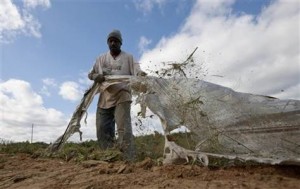In Alabama, First They Came For Blacks, Then Immigrants, Now Prisoners…
I write a lot about the history of the convict leasing system on this blog. I don’t think we can properly consider U.S.labor, racial, or penal history without a thorough understanding of that pernicious system.
After chasing many immigrants off resulting in tons of agriculture jobs being unfilled, the state of Alabama has a bright new/old idea. The state is considering using prisoners to fill the void left by the flight of immigrant labor:
“Agriculture officials in Alabama are looking into using prisoners to fill a labor shortage that the agency blames on the state’s controversial new law targeting undocumented immigrants.
The Alabama Department of Agriculture and Industries is meeting with south Alabama farmers and businesses in Mobile on Tuesday. Deputy commissioner Brett Hall says the agenda includes a presentation on whether work-release inmates could help fill jobs once held by immigrants.
Hall says planting season is coming up, and some growers fear most of their workers are gone. The agriculture agency says the new law has caused a chronic labor shortage on Alabama farms.”
Anyone who knows anything about Alabama’s sordid history of convict leasing should not be surprised that the state would turn to prisoners to do the back-breaking work that others will not do.
Mary Ellen Curtin’s excellent study about black prisoners in late 19th century Alabama illuminates episodes in American history that are pretty much unknown to us. Curtin contends that Alabama Democrats in the late 1800s turned to the convict lease system to address the state’s financial troubles. Coal companies were happy to make use of this convict labor but they were not the primary force pushing the practice. Curtin suggests that the lease system in Alabama left a lasting legacy:
“In the words of Populist critic William H. Skaggs, the lease was ‘vile,’ ‘pernicious,’ ‘excrable,’ ‘venal,’ and ‘brutal.’ It perpetuated ‘despotism’ by binding Alabama’s mineral interests to its political elite. It held the legal system hostage to the crass self-interest of county sheriffs, who collected fees for every prisoner they arrested, and politicians, who refused to forgo revenue paid for in human suffering. It linked race and criminality in a new and powerful way. It generated peonage by forcing convicted individuals to escape prison by allowing a local white landowner to pay their fine and thus control their labor. The lease shaped Alabama’s political economy and contributed to the legalized repression of African Americans during the age of segregation. Government officials and corporations willingly and knowingly traded prisoner’s lives for profit and revenue (p.10).”
Now that the state of Alabama has run off the undocumented workers who were willing to take on back-breaking agricultural work, they are planning to return to their tried and true ways of exploiting prisoners. We should remember Alabama’s history and legacy of convict leasing and we should strongly oppose a reinvented version of that system. We should reject trading the lives of undocumented immigrants for the lives of prisoners.

